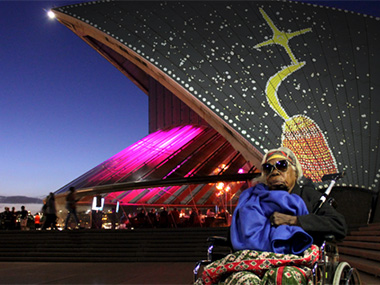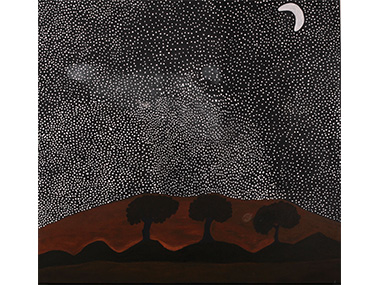Desecration in the East Kimberley

The aged Mabel Juli at the Sydney Opera House for the screening of her 'Garnkiny Ngarranggarni' (Moon Dreaming) imagery on to its sails
Jeremy Eccles | 25.06.20
Author: Jeremy Eccles
News source: Press Release
According to Elders from the art community of Warrmun, supported by the Kimberley Land Council, sites of cultural significance in the East Kimberley have been destroyed by large-scale granite mining operations, despite breaching Section 17 of the Aboriginal Heritage Act 1972 (WA). Located 50kms north of Halls Creek and within the Malarngowem Native Title Area, the site is under an exploration licence operated by Kimberley Granite Holdings.
The company took over the tenement in March 2019 and damaged protected sites. The company did not apply for a Section 18 consent to destroy an Aboriginal site under the Aboriginal Heritage Act – as was notoriously done by Rio Tinto recently - until a year later. The application was turned down by the WA Minister for Aboriginal Affairs, Ben Wyatt on June 4. An aerial viewing of the site on June 7 by Traditional Owners and the Kimberley Land Council uncovered ongoing operations.
The area is part of an important cultural dreaming site called 'Garnkiny' (Moon Dreaming) made famous by senior TO and well-known artist, Mabel Juli, whose paintings of the Dreaming story which explores forbidden love, kinship and mortality, have won the Kate Challis Award, been projected on to the Sydney Opera House sails and hung on the walls of the National Gallery of Australia. The destruction of the area is causing significant distress for the Traditional Owners, the Malarngowem people, and the destruction of these sites is an offence under the Aboriginal Heritage Act.
Former Jirrawun artist, Rusty Peters (84) and famous for his 7-panel 'Waterbrain' painting in the AGNSW considering birth, life and death in Gija thinking, with his sister Mabel Juli (88) are the recognised custodians of the land and are responsible for keeping it safe. “When I first heard about the mining I was shocked,” said Peters. “I didn’t know about it. I didn’t give the company permission. I didn’t give anyone authority to make this decision for me. I thought it had stopped. This makes me very worried as I have to give permission for such things to happen on Darrajayn country. I’m not going to stop worrying, white people cutting our culture up”.
In October 2019, the Kimberley Land Council, on behalf of the Malarngowem Traditional Owners, informed Kimberley Granite in writing that significant Aboriginal sites were being destroyed and they should stop works, restore the site and enter into a heritage protection agreement with the Traditional Owners to prevent further damage. Kimberley Granite declined to do so.
This March, the company was informed in writing by the State government that there was an Aboriginal heritage site at the location and works should stop.
Nolan Hunter, CEO of the KLC, said the Aboriginal Heritage Act is not working to prevent destruction, but only to regulate the manner in which it happens. “This is the fundamental flaw that is enabling the continued destruction of Aboriginal sacred sites”, he said. “The combination of weak legislation, inefficient government policy and the industry knowing State and Federal laws won’t stop them doing what they want is putting enormous pressure on Traditional Owners. They continually have to prove their rights through a legal system geared toward industry and against their interests.
“Whilst we welcome the Minister declining the Section 18 application, it didn’t stop the damage being done and it can’t undo that damage now. The Malarngowem TOs should not be forced to sit back and watch their cultural sites being destroyed when the Government, which is supposed to protect our cultural heritage, has the power to act. We are calling on the State to bring a prosecution against Kimberley Granite for their blatant and unlawful breaches of the Act”.
Ms Juli, who visited the site recently, has expressed her concern about what might happen now the mining has destroyed or damaged their sacred places. “I will have to jarrak (talk) to my old people, talk to my mother and my grandfathers and tell them what happened,” she said. “I’ll tell them that there was nothing I could do to stop it. I didn’t know what was happening.”
Mabel Juli has explained in art exhibition catalogues the importance of the stories associated with the site. “My mother told me that Goorlabal (the Rainbow Snake) came out from there when my grandmother died, might be he felt sorry for my grandfather. There is a track right across Springvale Station that Goorlabal left in the Ngarranggarni (Dreaming). There is a track in the black soil and one big long rock that runs across the country. Goorlabal came out of the ground at Nyawawoorroon. He went down to a place called Ngamarran and went into the hill where my brother was born”.
Unfortunately, that “big long rock” seems to be granite.
In awarding Mabel Juli the 2010 Kate Challis Award, the judges were particularly impressed by the sparse, dynamic and multilayered nature of her related 'Garnkiny Ngarranggarni' (Moon Dreaming). “Incorporating natural pigments, this painting literally draws on Juli’s country and invokes the ancient, enduring essence of the Dreaming. At the same time, the work communicates across many cultural symbols, presenting an interplay between various artistic forms and between many beliefs and traditions. It is a poetic, sophisticated work which is deeply grounded in Indigenous tradition, but also extends outward to suggest the complex relationships existing between a diversity of both cultural and natural human experiences”.
Back in The Kimberley, on May 29, in an attempt to obtain the support of Government for action to protect the site, the Kimberley Land Council requested that the Minister for Mines issue a stop-work order to Kimberley Granite. No response to this request has yet been received, and as of June 7th, large earth-moving machinery was still being used on the site. The following week, Kimberley Granite applied to the National Native Title Tribunal to approve the grant of their mining lease.
“This is a clear indication that they have no intention of stopping, and there is a 99% chance that they will get it. This is yet another way industry can by-pass heritage laws to get what they want,” said the KLC's Hunter.
A website has now been set up to campaign for the Gija elders and is worth joining. See below.
URL: https://www.garnkinynotgranite.com/
Share this:
»  del.icio.us
»
del.icio.us
»  Digg it
»
Digg it
»  reddit
»
reddit
»  Google
»
Google
»  StumbleUpon
»
StumbleUpon
»  Technorati
»
Technorati
»  Facebook
Facebook
Contact Details

Rusty Peters painting 'Three Nyawana' (2016) in the National Gallery's Triennial, combining his skin brother the Moon with three people Garnkiny turned into trees

The contentious granite mining site viewed on June 11th this year by photographer Matt Deakin
Further Research
Artists: Mabel Juli | Rusty Peters
News Tags: Ben Wyatt | Jeremy Eccles | Kimberley Granite Holdings | Kimberley Land Council | Ngarranggarni | Rio Tinto | Warmun
News Archive
- 02.07.20 | Yiribana
- 26.06.20 | Fashion Goes Indigenous
- 25.06.20 | Desecration in the East Kimberley
- 19.06.20 | The Gambay Language Map
- 09.06.20 | ARTISTS HONOURED
- 09.06.20 | ONLINE SYDNEY FILM FESTIVAL
- 03.06.20 | “An Archive of the Industry”
- 02.06.20 | RIP Malu Gurruwiwi – Custodian of the Banumbirr
- 31.05.20 | The Beach
- 27.05.20 | First Nations Arts Awards
- 21.05.20 | Media Muddles Aboriginal Politics
- 20.05.20 | The War in Mparntwe
- 18.05.20 | COOKED 2
- 14.05.20 | 'Truganini – Journey Through the Apocalypse'
- 11.05.20 | BIDYADANGA CLOSE-UP
Advertising

